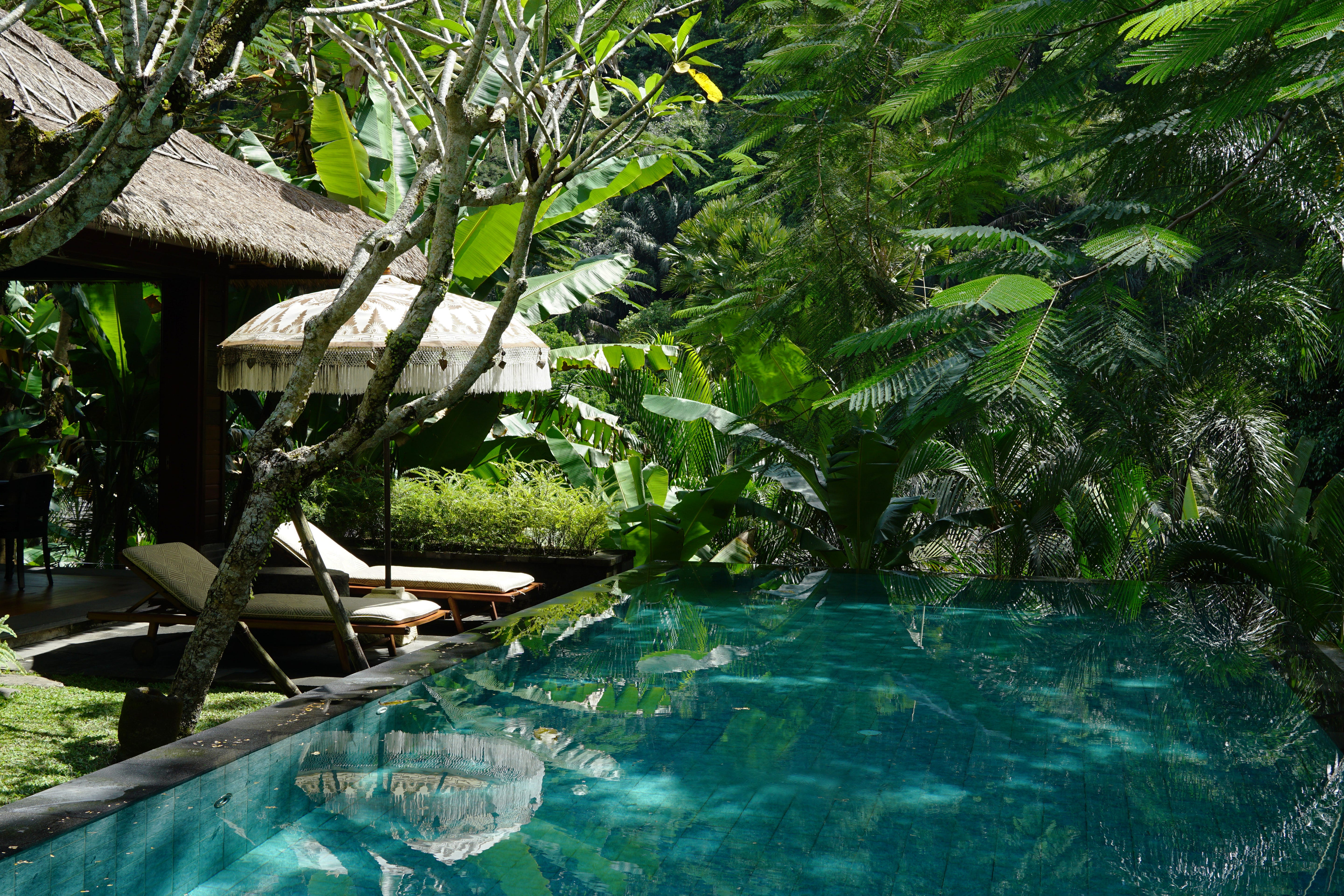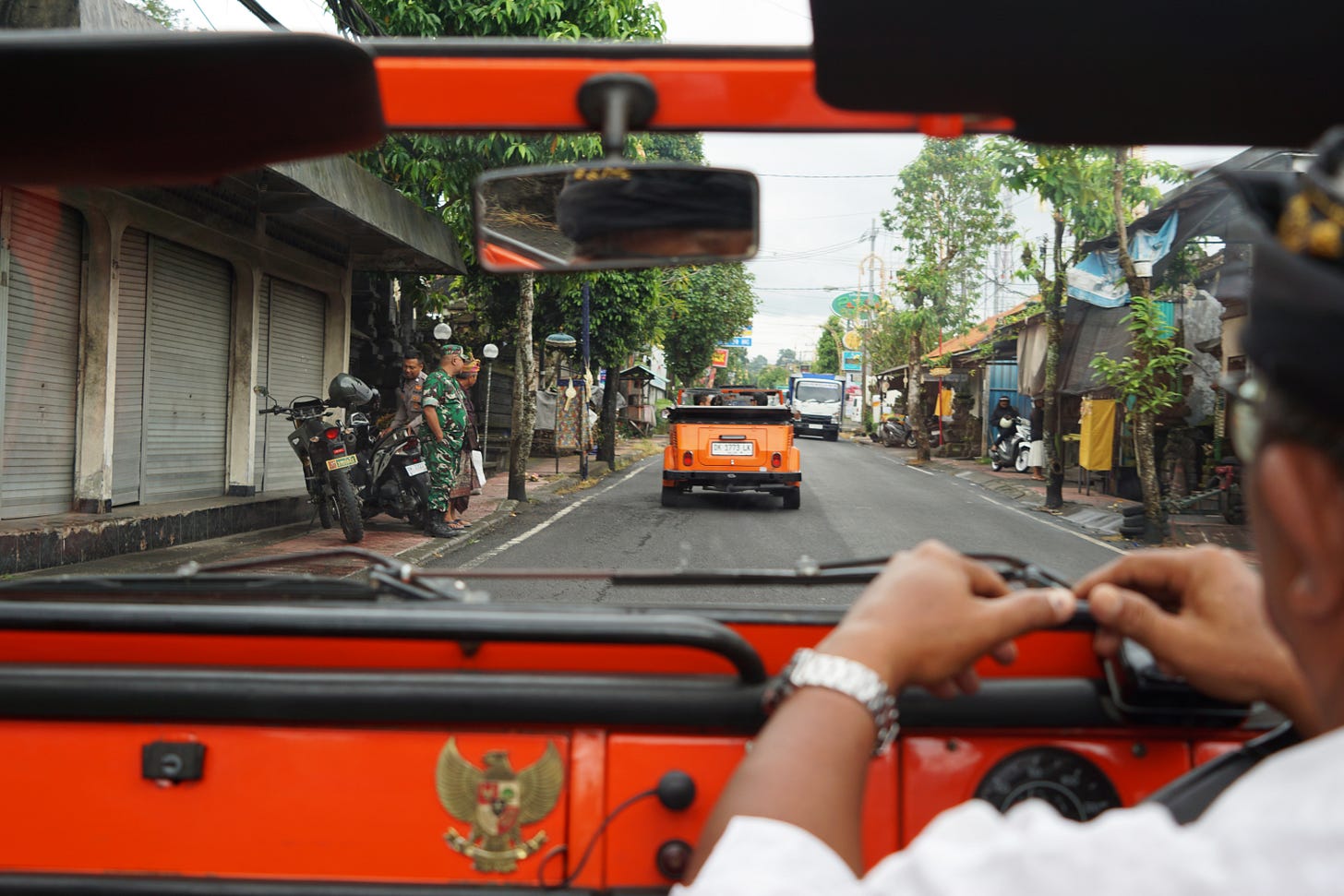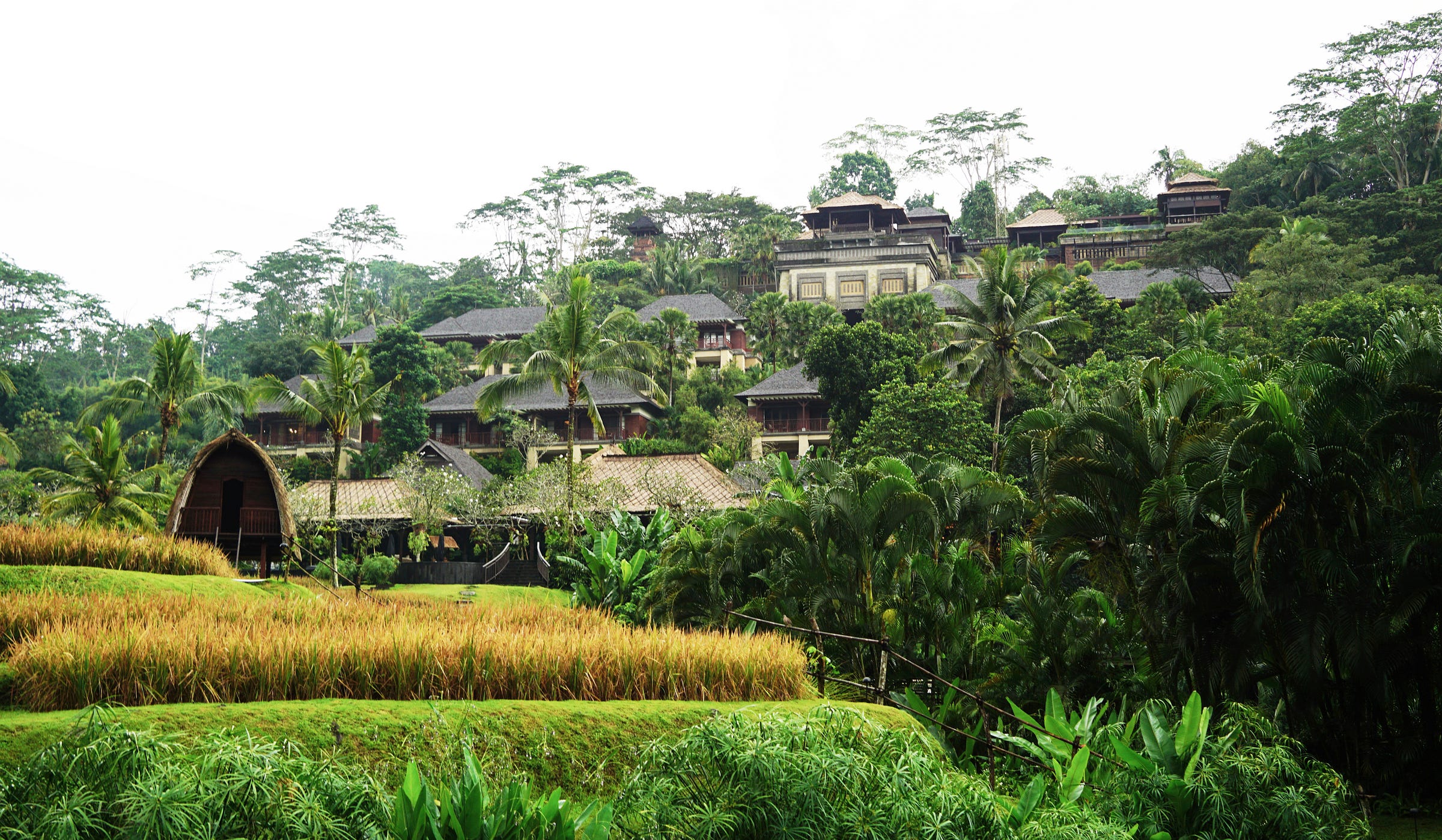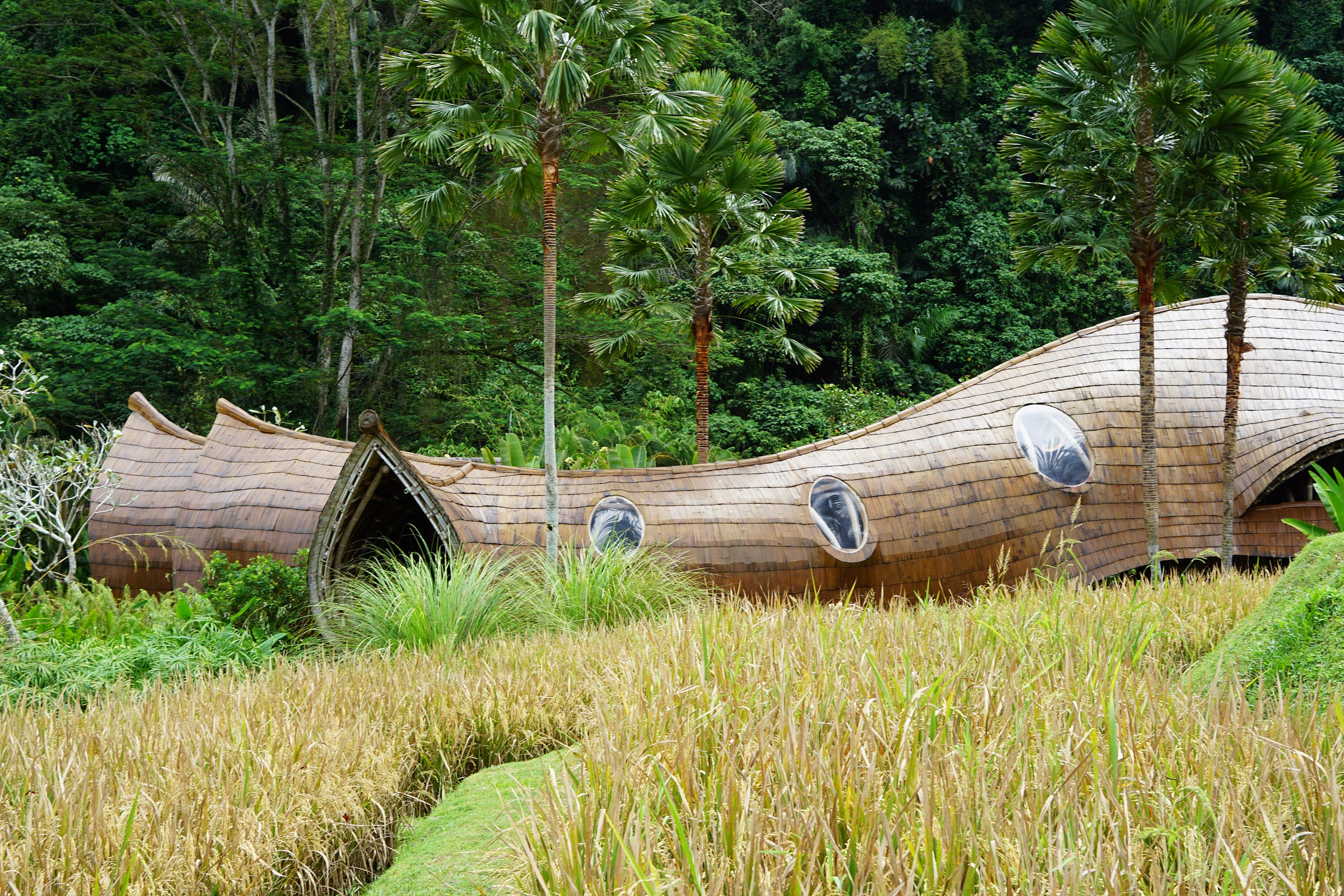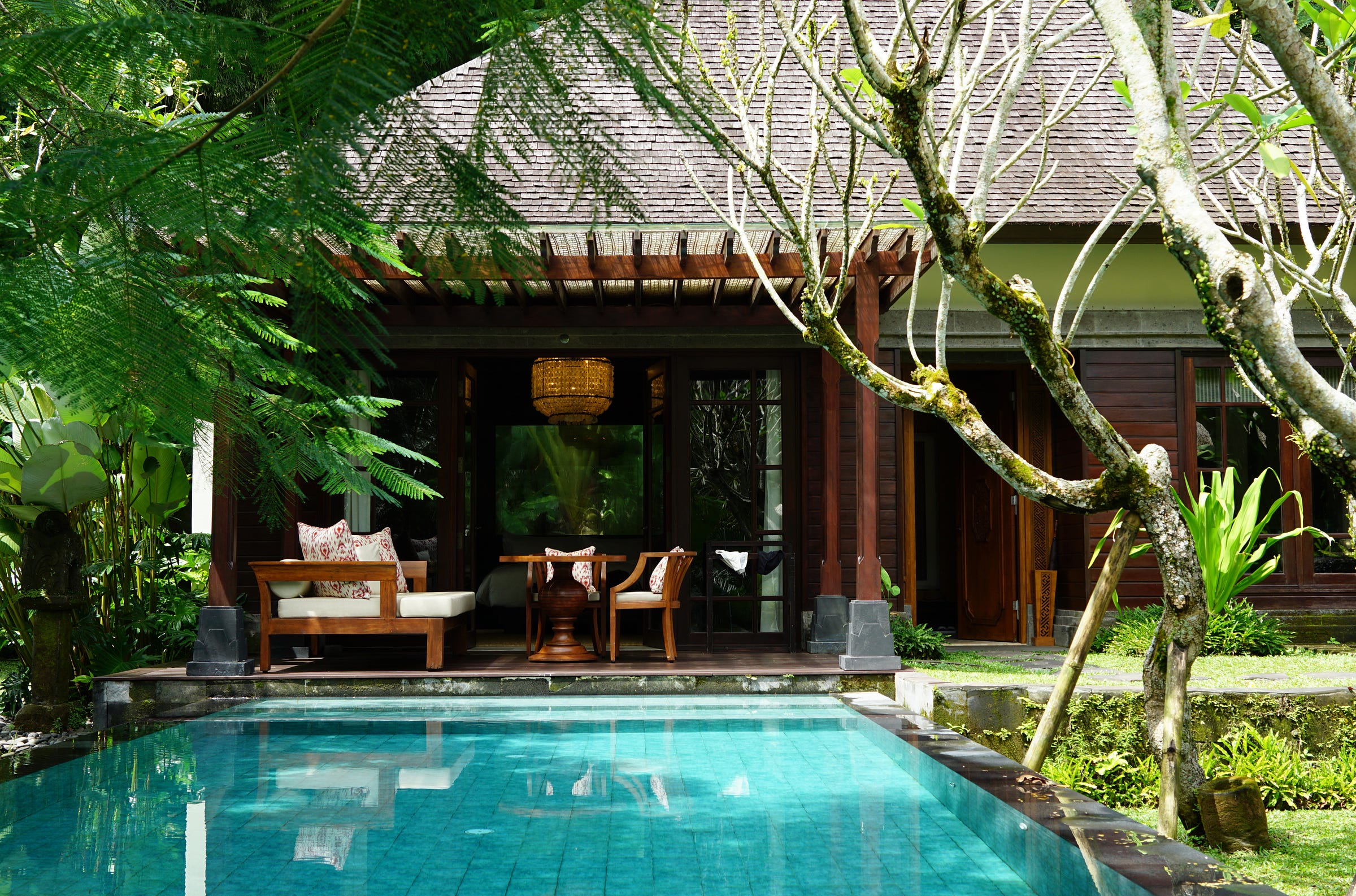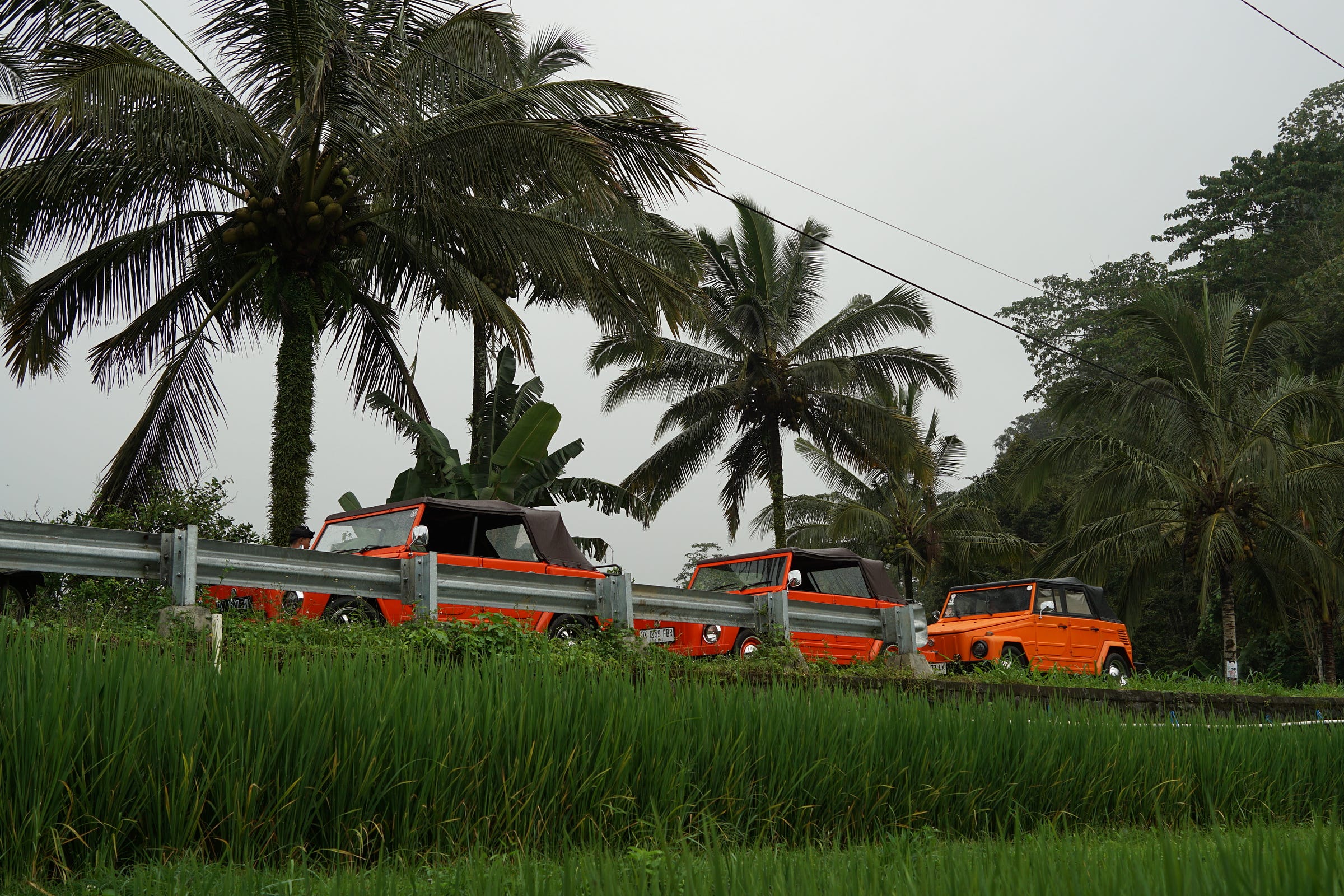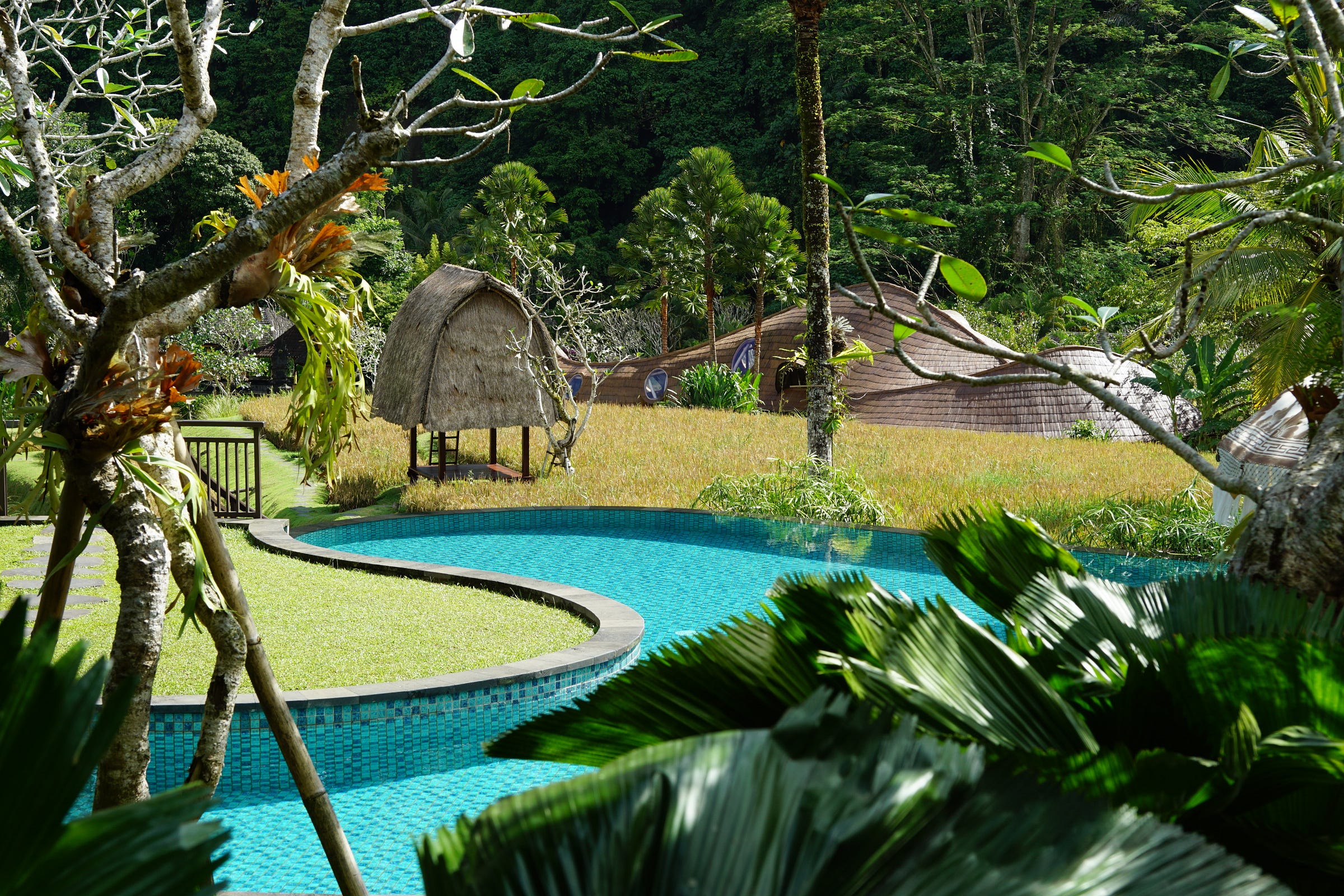Spirited Away to Bali
Issue 010: Over-eating, praying(?!), and falling in love with Balinese culture at Mandapa.
Introduction
I have never been a spiritual person. I even roll my eyes to myself as soon as anyone mentions astrology (very Aquarius of me, I’m told). My brain is firmly rooted in logic, facts, and proof—perhaps to a fault—and therefore I have never really connected with any ideas beyond what I can see and hear around me. I’m not at all closed-minded, and I fully support anyone else’s connections to religion or/and spirituality (and will fight ardently for everyone’s rights to exercise their beliefs, as long as it causes no harm to others). But it’s just not for me.
That was until a recent trip to Bali, during which I was immersed in a culture and its practices in a way that made me delve into the purpose of spirituality, and wonder if I was missing out. Travel has a knack for provoking introspection—you have a lot of time with your own thoughts, in places that upend typical routines, and are exposed to new ways of living and thinking. So it’s natural to observe, to question, and to get in your own head. I believe everyone should take a solo trip at least once in their lives, if they’re able to, because it opens up experiences just like the one I had. Although this particular trip wasn’t entirely solo (I was with two other journalists and a brand representative), I did have enough time alone to contemplate.
Excitingly, this is the furthest I’ve been “flung” since starting this Substack, and my first trip to Asia in over a decade. I was invited to experience three Ritz-Carlton properties: The Ritz-Carlton Bangkok, The Ritz-Carlton Bali, and Mandapa, a Ritz-Carlton Reserve—quite the itinerary for 12 days. However, my journey over there was less than ideal.
I was weirdly looking forward to the 15-hour flight from NYC to Mumbai, then another 4.5-hour leg to Bangkok, because it seemed like an ideal time to be productive with few distractions. But the Air India wi-fi was not up to much, so I couldn’t get any work done. And much worse, the flight was delayed out of JFK so I missed my connection in Mumbai. With no other direct flights to Bangkok for 24 hours, and no ability to leave the terminal because I didn’t have a visa for India, I was stuck in “airport purgatory” for 10 miserable hours. I eventually rebooked on Batik Air (which I’d never heard of?!) via Kuala Lumpur, and [I lost count how many] hours later, I was in Bangkok. But let’s skip forward a few days… After a whirlwind tour and a tuk-tuk bar crawl around the Thai capital, then a much smoother journey to Bali and a magical three nights in Nusa Dua (all to be recounted in-full another time), I finally got to the part of the trip I was most eagerly anticipating.
Bali
Bali has been high on my list of dream destinations for so many years. Beyond the Eat, Pray, Love fantasy that Julia Roberts instilled in me, the Indonesian island has always had a magical draw that I couldn’t shake: the rainforests, the beaches, the temples, and the mystery surrounding its unique culture and customs.
Aside from a hungover day trip from Singapore to Bintan in my 20s, when I experienced the worst sunburn of my life, this was my first real trip to Indonesia—one of the world’s fastest growing populations, spread across an archipelago of over 17,000 islands. Of all these, Bali receives the most visitors, and has done a great job over the years of marketing itself as a desirable destination. Many travelers to Bali opt for the beach, surf, and party culture of Kuta and Seminyak, on the island’s southwest coast, while others venture inland for the rainforest, religious sites, and volcano hiking—or, since coming all this way, combine both. I think there are better beaches in other parts of SE Asia, so the latter is personally more enticing.
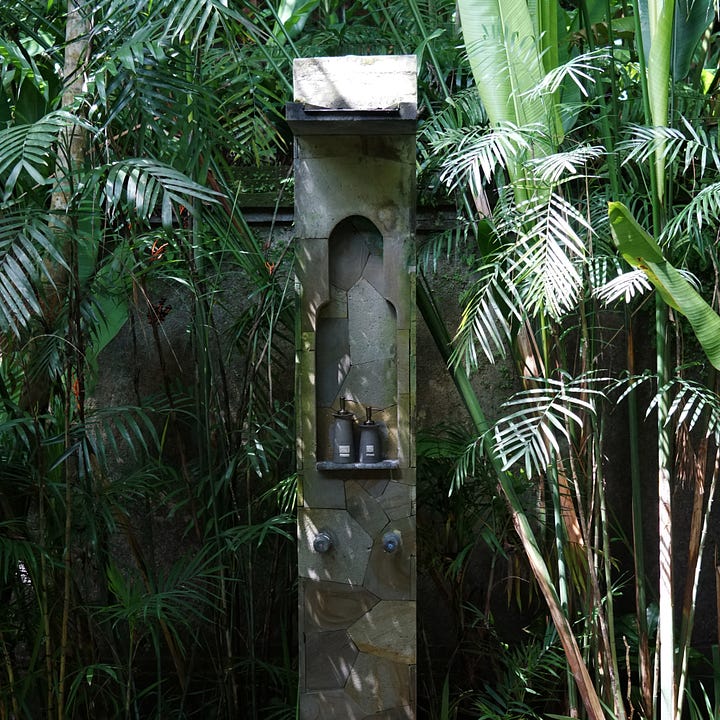
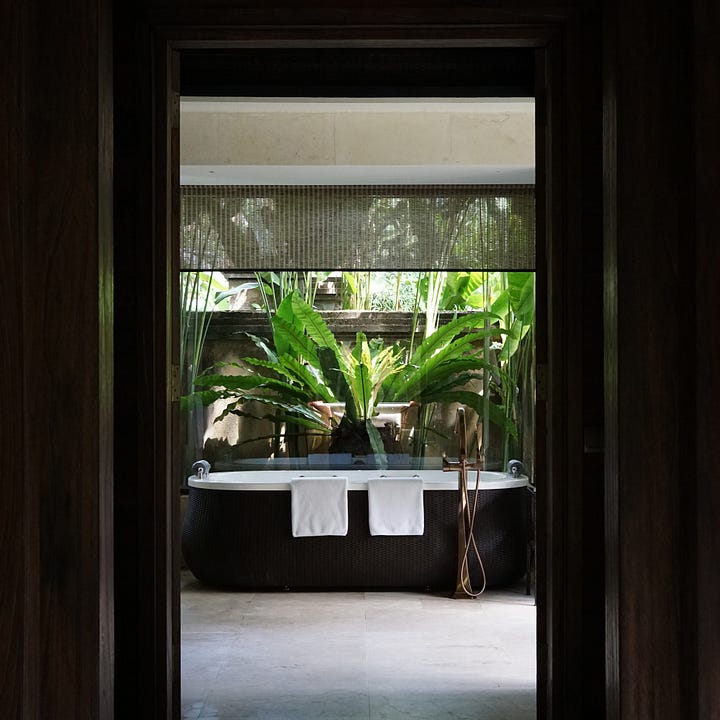
Although Indonesia is a majority Muslim country, Balinese people by-and-large follow a very specialized branch of Hinduism that’s a blend of Indian Hinduism, Buddhism, and indigenous animistic beliefs that developed centuries ago. Entwining ancestral worship and a vast pantheon of gods and goddesses, this culture is expressed through a unique architectural and craft style, daily rituals, annual festivals and celebrations, and an overall way of life that’s deeply connected to spiritual practices.
While it’s hot and humid year-round, Bali’s dry season is typically April to October. However, every local I met encouraged me to come back for Nyepi, the Balinese “Day of Silence”—the island’s new year celebration that takes place during the new moon in March. The night before this sacred festival, elaborate bamboo and paper-mache effigies known as Ogoh-Ogoh are paraded through the streets and then burned as a way to purify the world of evil spirits. Then, on “new year’s day,” the entire island goes dark and quiet. For 24 hours, flights are cancelled, electricity is turned off (except for emergencies), cell phones are cast aside, and the population is encouraged to spend time with family and reflect peacefully by candlelight. Also, due to the removal of light pollution, this is an ideal moment for stargazing. It sounds like heaven, and I would love to experience this one day. Instead, we were there early May.
Ubud
Ubud is the cultural and spiritual heart of Bali, and is home to many ancient temples, palaces, springs, and other religious sites. The city sprawls across unusual geography: finger-like ridges stretch down from the volcanoes further north, with deep, densely forested gorges and fast running rivers in between. Main roads follow the ridges and are lined with commercial and residential buildings either side, while terraced rice paddies fill the flatter areas, and small roads and bridges link them all together. There’s no real “center” of town, and it takes a long time to get anywhere on the narrow streets, as it’s common to get stuck behind slow-moving vehicles.
Ubud has recently become associated with the “digital nomad” crowd, and there’s a lot of westerners parading around town in sarongs, or posted-up at the myriad bars and cafes. But there are also some great local boutiques—I really liked Biasa for flowy linens—and plenty of spots where authenticity still rings true. Accommodation options cater for every budget, with many hidden deep in the jungle so that the street bustle feels miles away. The area offers hiking, caving, quad biking, white-water rafting, waterfall excursions, and of course, tours of the sacred monuments like the Water Palace, which we visited and watched visitors “purify” themselves during elaborate bathing rituals. Be warned: you’ll be hard-pressed to do more than a couple of things a day. I recommend staying at least a week.
Mandapa
This is one of the most unique properties I’ve ever stayed at. Mandapa is one of eight Ritz-Carlton Reserve properties around the world, each of which leans into its cultural context much harder than the brand’s typical hotels, which share a similar design style and amenity offering. In Bali, this equates to a stunningly beautiful property on land owned by a local family, which still farms the rice paddy at the property’s heart.
Arrival from the built-up area, along a seemingly innocuous alley, then past a guard post down to a traditional split gate known as a “candi bentar.” These stepped, decorated brick and stone gates are found across Bali and neighboring Java, everywhere from religious sites to private homes, and feature flat surfaces on either side of the entryway as if one structure has been halved down the middle and pulled apart. Once through this threshold and within the Mandapa perimeter, busy Ubud melts away, and a tranquil world that’s very close to my idea of heaven awaits.
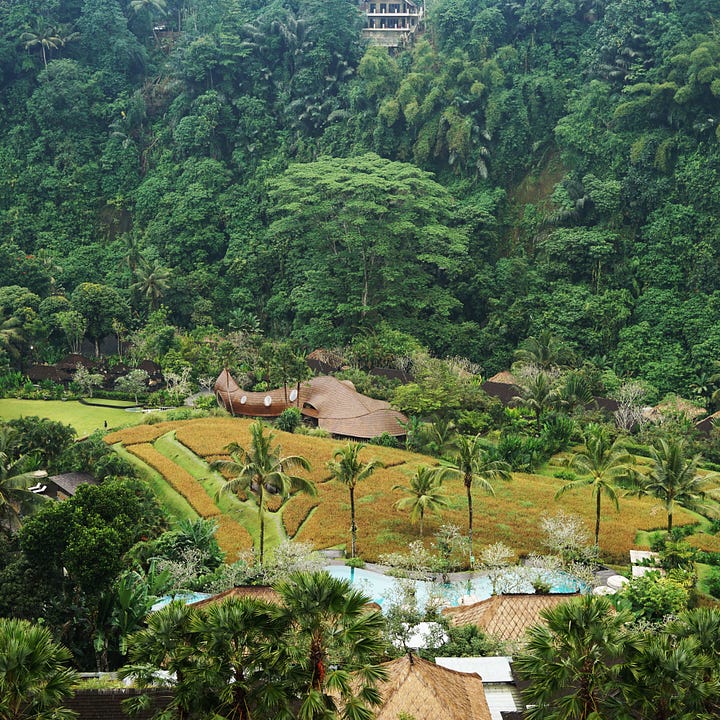

The hotel’s expansive lobby is perched high above a valley, through which a raging river that’s popular with white-water rafters cuts its path. From up in the open-sided buildings surrounded by shallow pools, the layout of accommodation and ancillary structures can be seen staggering down the slope all the way to the water. The steep site is best navigated by chauffeured golf buggy, which offers quite the thrill ride along precipitous paved tracks and around hairpin turns—especially if you’re facing backwards.
Throughout my stay, the service offered was impeccable. All of the staff, who refer to guests as “bapak” (sir) or “ibu” (madam), were friendly and chatty without being overbearing, and very happy to offer tidbits of local facts and knowledge with a smile. I really felt like I was experiencing an authentic slice of Bali, all while in a luxury resort—which is not easy to pull off.
Architecture & Design
It’s very hard to make something that’s only a decade old appear as if it’s been there for centuries, without looking like a pastiche. But Mandapa’s stone and wood buildings have settled gracefully into the hillside and allowed the tropical flora to do most of the work. Granted, the stonework was specially treated to give an aged appearance, and the landscaping is very intentional, but overall it looks effortlessly ancient in the places it’s supposed to. Traditional Balinese architecture has been interpreted fairly faithfully across the site, and guests are put under the spell of staying in a rural village—albeit a very fancy one.
One of the most striking architectural gestures on-site is the kid’s club, which occupies a snaking bamboo structure covered in wood shingles. A stark contrast to the pitched, thatched roof buildings across the property, this organic, contemporary volume cuts a striking silhouette against the deep green of the jungle behind. Another stand-out feature is the rice paddy hut, a small thatched structure right at the heart of Mandapa. This would typically be used as a shelter for farmers taking a break from harvesting their crops, and a place to store and dry the rice. Here, it’s a fun little folly that anchors the property and stands as a proud nod to Bali’s agricultural heritage.
Guest Rooms
I could easily have moved into the villa that was to be my secluded sanctuary for three nights. Mine (number 5) was one of the higher in elevation and most northerly of the 25 in this room category, which are scattered across the mid-to-lower areas of the site. Reached via a path of stepping stones, past tall moss-covered walls and a fountain, the gateway into my complex is topped with a traditional thatched roof. Beyond the wooden double doors, a lush oasis awaits.
The spacious, luxurious suite encompasses a main building with a large bedroom on one side and an equally roomy bathroom on the other. In the bedroom, walls are hand-painted in a traditional style (think The White Lotus season three opening sequence) and windows frame the tropical foliage outside. Glass doors swing open to a terrace that overlooks the infinity pool, stretching into the jungle beyond—a truly gorgeous setting of which I took way too many photos.
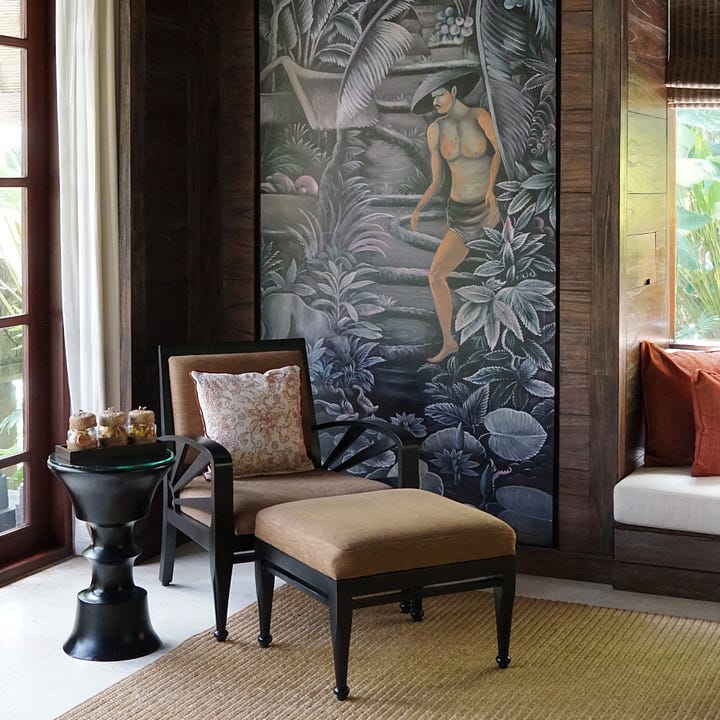
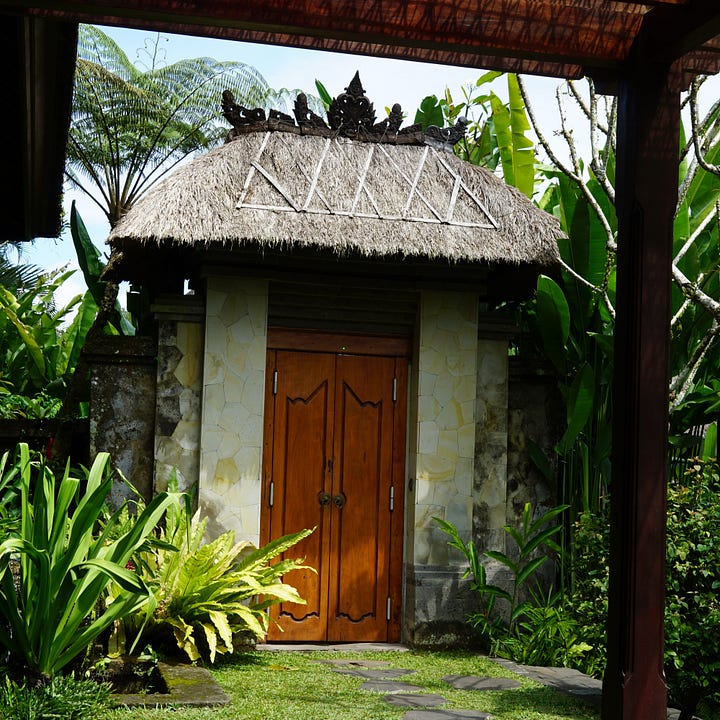
The bathroom features a vanity on either side (I used one for hand/face washing and teeth cleaning, and the other for fixing my hair, because why not?), as well as a large soaking tub, and separate spaces for the Japanese-style toilet (the all-singing kind) and a shower. Beyond the indoor shower is another outside that’s surrounded by huge tropical leaves and has stones underfoot, providing the stage for your very own Herbal Essences commercial whenever it’s time to rinse off. I personally love an outdoor shower and if it’s there, it’s all I’ll use.
The villa suite also has a separate pitched-roof pavilion a few steps away containing a living area for relaxing and watching TV, as well as a desk if needed, with sliding screens that open the space fully to the elements on three sides. Surrounded by greenery, this room is somehow both airy and cozy, and the low lighting at night both inside and across the landscaping really sets a seductive mood. In-room amenities include a batik-patterned robe (embroidered with my full name), and a straw hat and bag (which came in handy during one of our excursions). I honestly didn’t ever want to leave the villa at all, and would’ve been perfectly content to have spent the full duration relaxing within its confines. But I had a job to do.
Dining & Drinking
Julia Roberts may have done the “eat” portion of her global journey in Italy, but really she could’ve just come straight to Bali for that too. Indonesian cuisine is so flavorful and the ingredients—particularly fruits like mango, my fave—are incredibly fresh. I ate so much on this trip that it’s a miracle I didn’t gain more weight. Mandapa’s dining options include Ambar, located just off the lobby and with breathtaking views across the valley from its lofty perch. Open to outside diners as well as hotel guests, the restaurant serves a delicious sushi-forward menu, but this is really the spot to come for sunset cocktails (I made my way through most of the list; all great) when it’s buzzy with beautiful people.
Lower down, Sawah Terrace (where the buffet breakfast is also served) is the most locally authentic option, celebrating Indonesian cuisine against a backdrop of traditional music and dance performances. During the day, The Pool Bar has more Western and international dishes for the less adventurous—many of which are also available on the in-room dining menu. Eating in the villa, which I did a couple of times, is highly recommended as the setting is so stunning and all of the food is top notch. Finally, for fine-dining, riverside Kubu offers an experimental 10-course menu based on a zero-waste philosophy. All of the ingredients are sourced from within 100 km of the hotel, and the dramatic bamboo structure and series of private tables within basket-like pods—modeled on traditional fishing equipment—make for a surreal evening setting.
Amenities & Experiences
Having already been spoiled with two massages on this trip, I opted for a facial that incorporated 24K gold leaf for my complimentary spa treatment, and thanks to the churning sounds of the river just outside the treatment room, it was just as relaxing as a massage would’ve been. Saunas and steam rooms are available in the chicly decorated changing rooms, while a gym (didn’t have time, again) and rooms for group therapies also feature in the spa complex at the bottom of the site. In one of these rooms we were given a Sound Bath, which put me straight to sleep.
Elsewhere, the hotel has a communal swimming pool in front of the breakfast restaurant, overlooking the rice paddy and the opposite slope, which I didn’t get a chance to enjoy either—mainly because I spent the time in my villa’s private pool. I already mentioned the kid’s club, which appeared to be very well programmed with activities that include daily visits from two cows who would stop by for photo ops.
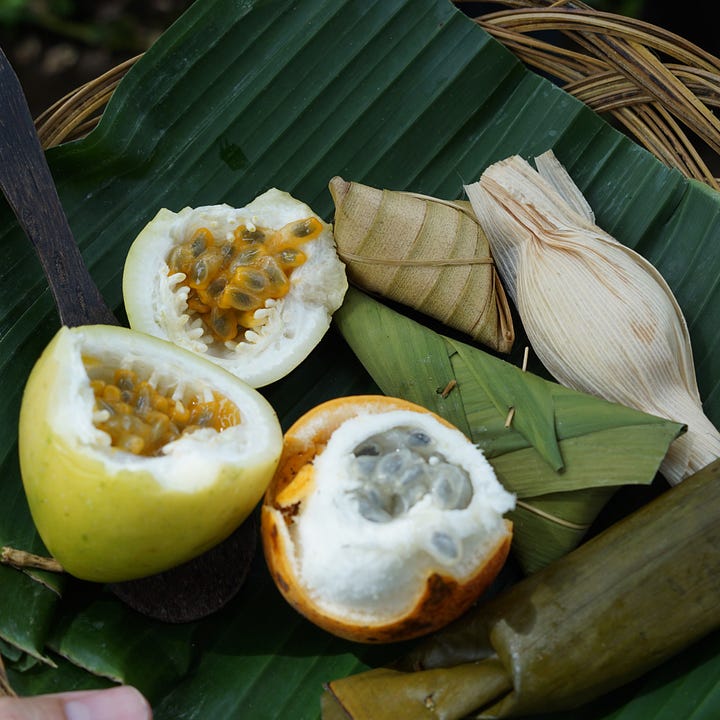

One of the off-property experiences we were able to enjoy was a foraging excursion with Chef Eka. In a fleet of bright orange Volkswagen Acapulco Things (open-top optional, very much weather-dependant), we convoyed north to a community farm where the chef led us through the jungle to point out various types of plants, herbs, fruits used in his cooking, and had us taste many along the way. At the end of the short hike, a spread of pre-prepared delicacies and fruits were waiting for us to sample, with the promise that we’d taste more during our meal at Kubu later in the trip.
Fire Blessing Ceremony
Another of the experiences on my itinerary was a Fire Blessing Ceremony at Mandapa’s historic temple, which was used by the landowners long before the hotel arrived. Admittedly, I initially wasn’t super keen on spending two hours of my short time at the resort engaged in an activity to which I had no connection or real need. But not wishing to offend, and for the sake of journalism, I joined in with the group.
Dressed in traditional garments provided to us, we sat in a circle on a podium around a small central fire and in front of a priest, who had fasted for two days prior in order to perform the ceremony. I won’t provide a blow-by-blow account, but in essence, the priest blessed foods and grains with water for us to toss into the fire while we chanted mantras in unison. At one point, we had to smash coconuts on the ground as a way to break our bad habits and throw out our insecurities. The whole thing took a long time, it was hot, and my legs began to cramp from sitting too long. But it did compel me to consider why these kinds of rituals are part of so many cultures, and the benefits of having the opportunity to get lost in one’s thoughts.
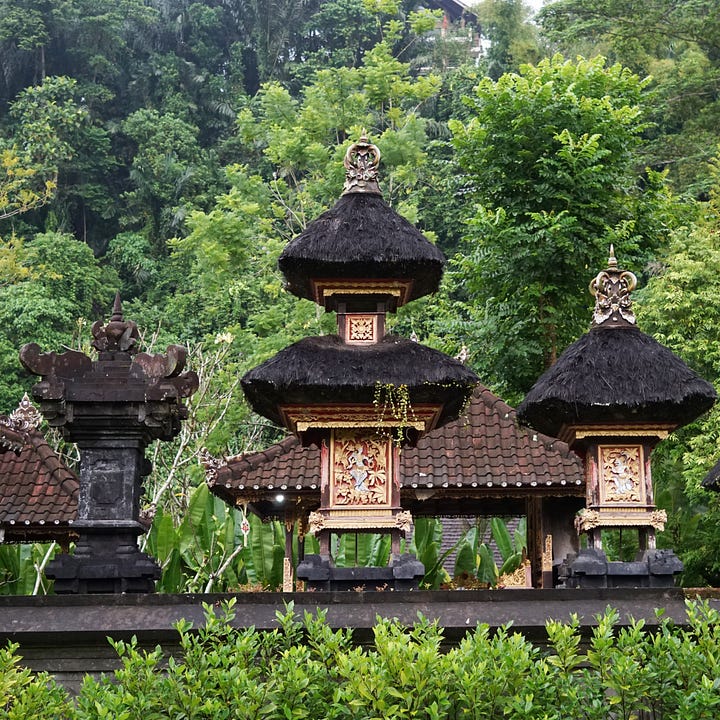
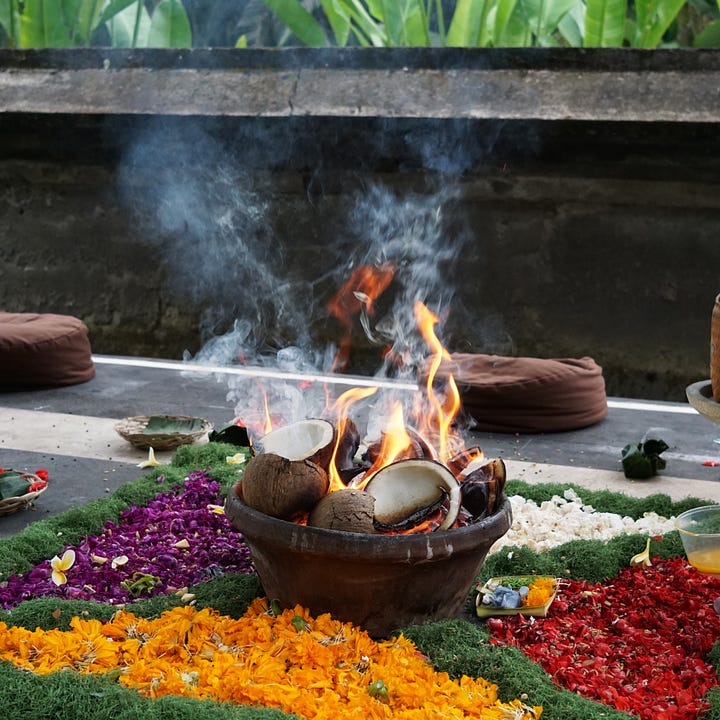
Spirituality gives us meaning and purpose in an otherwise meaningless and purpose-less world. It once provided our ancestors with answers to questions that they didn’t have the means or tools to comprehend, and it still does the same for us today. Prayer creates space and time to reflect; to think about what we want; decide what we want to leave behind; celebrate who we love; remember who we miss. It’s a powerful moment we have to ourselves, to use however we wish. And I’m beginning to understand the importance of that.
I’m by no means a religious convert. But I do think that this ceremony, and the greater immersion in a culture that expresses its spirituality so vibrantly, allowed me to deepen my appreciation for others’ connections to religious practices, and has encouraged me to integrate more moments of pause and reflection into my daily life. I’m very grateful to have had this opportunity, and it reaffirmed to me the importance of these kinds of experiences that only travel can offer. Anyone who’s able to should get out of their comfort zone and immerse themselves in another culture. I guarantee they’ll be all the better for it.
Thank Yous
Another lengthy list this time! Thank you to Nathan Kovach from BPCM for initially inviting me on this incredible trip. To his colleagues Diona Richardson, Talia Kairouz, Dhani Hoyte, and Lauryn Bivens for arranging travel and trying to rebook my missed flight even though it was 4am in NYC. Emily Moir from the Ritz-Carlton team, so many thanks for shepherding us around Asia, making sure we were happy and well looked after, and being the travel companion who was always ready for a cocktail with me. Thanks to Maddie Flagler for enduring our nightmare travel day together with composure and a smile, then being such a great sport through every activity we did as a group. And thanks to Ritu Upadhyay for being my personal trip photographer, and for always having a great story to tell over dinner.
The Mandapa team!! Thanks endlessly for being so full of joy, laughter, and enthusiasm during all the time you spent with us. A special thanks to Chef Eka for taking us foraging, sharing his incredible knowledge and passion for food, and preparing such delicious, authentic Indonesian dishes for us. This is a trip I will never ever forget. D x





